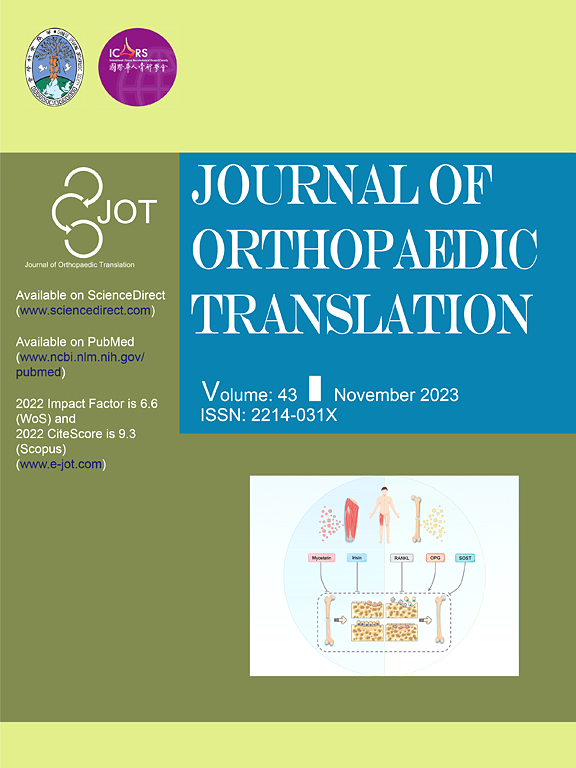An aptamer specifically targeting mCRP ameliorates experimental arthritis
IF 5.9
1区 医学
Q1 ORTHOPEDICS
引用次数: 0
Abstract
Background
Recent evidence highlights the important role of the liver–bone axis in the development of arthritis, particularly rheumatoid arthritis (RA) and osteoarthritis (OA). The liver secretes various factors that impact joint health, one of which is C-reactive protein (CRP), elevated in RA and OA patients. Traditionally regarded as an inflammatory marker, the causal role of CRP in arthritis development remains a topic of debate due to the existence of its two isoforms with opposing functions: native pentameric CRP (nCRP) and monomeric CRP (mCRP).
Methods
We generated hepatocyte-specific CRP knockout mice to investigate the causal role of CRP in RA and OA mouse models. In vitro experiments were conducted to assess the effects of mCRP and nCRP on phenotypic changes in effector cells common to RA and OA, including fibroblast-like synoviocytes (FLSs), monocytes/macrophages, and chondrocytes. Using systematic evolution of ligands by exponential enrichment (SELEX), we screened nucleic acid aptamers targeting mCRP rather than nCRP. We determined the neutralizing effects of the selected aptamers on mCRP in vitro and explored their therapeutic potential and safety in RA and OA mouse models.
Results
Hepatocyte-specific knockout of CRP significantly reduced disease severity in RA and OA mouse models. mCRP promoted in vitro pathological changes in FLSs, monocytes/macrophages, and chondrocytes, while nCRP exhibited minimal or slightly protective effects. We identified an aptamer, ApmCRP3, which effectively inhibited mCRP-induced pathological changes of RA and OA effector cells in vitro. In mouse models of RA and OA, ApmCRP3 displayed strong therapeutic effects and a favorable safety profile.
Conclusion
This study identifies hepatocyte-derived mCRP as a contributor to RA and OA pathogenesis and highlights ApmCRP3 aptamer as a promising therapeutic candidate.
The translational potential of this article
This study highlights the therapeutic potential of ApmCRP3 in attenuating mCRP-driven pathology and controlling arthritis progression.

特异性靶向mCRP的适体可改善实验性关节炎
最近的证据强调肝-骨轴在关节炎,特别是类风湿性关节炎(RA)和骨关节炎(OA)的发展中的重要作用。肝脏分泌各种影响关节健康的因子,其中之一是c反应蛋白(CRP),在RA和OA患者中升高。传统上被认为是一种炎症标志物,CRP在关节炎发展中的因果作用仍然是一个有争议的话题,因为它存在两种功能相反的亚型:天然五聚体CRP (nCRP)和单体CRP (mCRP)。方法制备肝细胞特异性CRP敲除小鼠,研究CRP在RA和OA小鼠模型中的因果作用。体外实验评估mCRP和nCRP对RA和OA常见的效应细胞(包括成纤维细胞样滑膜细胞(FLSs)、单核/巨噬细胞和软骨细胞)表型变化的影响。利用指数富集配体的系统进化(SELEX),我们筛选了靶向mCRP而非nCRP的核酸适体。我们在体外测定了所选适配体对mCRP的中和作用,并探讨了它们在RA和OA小鼠模型中的治疗潜力和安全性。结果造血细胞特异性敲除CRP可显著降低RA和OA小鼠模型的疾病严重程度。mCRP促进了FLSs、单核/巨噬细胞和软骨细胞的体外病理改变,而nCRP表现出最小或轻微的保护作用。我们在体外鉴定出一种适体ApmCRP3,它能有效抑制mcrp诱导的RA和OA效应细胞的病理变化。在RA和OA小鼠模型中,ApmCRP3显示出强大的治疗效果和良好的安全性。结论本研究确定肝细胞源性mCRP参与RA和OA发病机制,并强调ApmCRP3适体是一种有前景的治疗候选体。本研究强调了ApmCRP3在减轻mcrp驱动的病理和控制关节炎进展方面的治疗潜力。
本文章由计算机程序翻译,如有差异,请以英文原文为准。
求助全文
约1分钟内获得全文
求助全文
来源期刊

Journal of Orthopaedic Translation
Medicine-Orthopedics and Sports Medicine
CiteScore
11.80
自引率
13.60%
发文量
91
审稿时长
29 days
期刊介绍:
The Journal of Orthopaedic Translation (JOT) is the official peer-reviewed, open access journal of the Chinese Speaking Orthopaedic Society (CSOS) and the International Chinese Musculoskeletal Research Society (ICMRS). It is published quarterly, in January, April, July and October, by Elsevier.
 求助内容:
求助内容: 应助结果提醒方式:
应助结果提醒方式:


